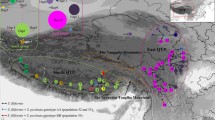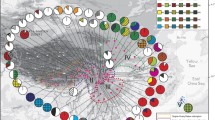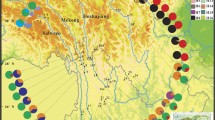Summary
Previous phylogeographic studies of arctic-alpine plants have partly elucidated that alpine areas at the southernmost edges of their distribution have been one of the most important areas for the survival of populations through Quaternary climatic oscillations. To reveal the genetic structure of arctic-alpine plants near the southern edge of their range in East Asia, 159 samples of Diapensia lapponica subsp. obovata (Diapensiaceae) were collected from 22 populations in Japan. Based on 1,134 bp of chloroplast DNA (cpDNA), we determined 10 haplotypes. Neighbor-joining (NJ) analysis, including D. lapponica from Sweden and Schizocodon soldanelloides, revealed that all haplotypes in Japan were monophyletic. Genetic differentiation between populations of central Honshu and northern Japan was strongly supported by the NJ tree (100%), analysis of molecular variance (AMOVA, 68%), and Monmonier’s algorithm (>95%). The most ancestral haplotype rarely occurred in Japan, which implied that the extant genetic structure was not caused by genetic divergence during colonization. Thus, these results suggest that the arctic-alpine plant D. lapponica subsp. obovata survived climatic oscillations in central Honshu. This finding supports the hypothesis that high mountains in temperate regions were important for survival of arctic-alpine plants during Quaternary climatic oscillations.
Similar content being viewed by others
References
Abbott RJ and Brochmann C (2003). History and evolution of the arctic flora: in the footsteps of Eric Hultén. Molec Ecol 12: 299–313
Abbott RJ, Smith LC, Milne RI, Crawford RM, Wolff K and Balfour J (2000). Molecular analysis of plant migration and refugia in the Arctic. Science 289: 1343–1346
Albach DC, Schönswetter P and Tribsch A (2006). Comparative phylogeography of the Veronica alpina complex in Europe and North America. Molec Ecol 15: 3269–3286
Alsos IG, Engelskjøn T, Gielly L, Taberlet P and Brochmann C (2005). Impact of ice ages on circumpolar molecular diversity: insights from an ecological key species. Molec Ecol 14: 2739–2753
Clement M, Posada D and Crandall KA (2000). TCS: a computer program to estimate gene genealogies. Molec Ecol 9: 1657–1659
DeChaine EG and Martin AP (2005). Marked genetic divergence among sky island populations of Sedum lanceolatum (Crassulaceae) in the Rocky Mountains. Amer J Bot 92: 477–486
Delaunay B (1934). Sur la sphère vide. Bull Acad Sci USSR 7: 793–800
Després L, Loriot S and Gaudeul M (2002). Geographic pattern of genetic variation in the European globeflower Trollius europaeus L. (Ranunculaceae) inferred from amplified fragment length polymorphism markers. Molec Ecol 11: 2337–2347
Doyle JJ and Doyle JL (1990). Isolation of plant DNA from fresh tissue. Focus 12: 13–15
Excoffier L, Laval G and Schneider S (2005). Arlequin ver. 3.0: an integrated software package for population genetics data analysis. Evol Bioinform Online 1: 47–50
Felsenstein J (1985). Confidence limits on phylogenies: an approach using the bootstrap. Evolution 39: 783–791
Fujii N and Senni K (2006). Phylogeography of Japanese alpine plants: biogeographic importance of alpine region of central Honshu in Japan. Taxon 55: 43–52
Fujii N, Ueda K, Watano Y and Shimizu T (1997). Intraspecific sequence variation of chloroplast DNA in Pedicularis chamissonis Steven (Scrophulariaceae) and geographic structuring of the Japanese “Alpine” plants. J Pl Res 110: 195–207
Fujii N, Ueda K, Watano Y and Shimizu T (1999). Further analysis of intraspecific sequence variation of chloroplast DNA in Primula cuneifolia Ledeb. (Primulaceae): implication for biogeography of the Japanese alpine flora. J Pl Res 112: 87–95
Godbout J, Jaramillo-Correa JP, Beaulieu J and Bousquet J (2005). A mitochondrial DNA minisatellite reveals the postglacial history of jack pine (Pinus banksiana), a broad-range North American conifer. Molec Ecol 14: 3497–3512
Grivet D and Petit RJ (2003). Chloroplast DNA phylogeography of the hornbeam in Europe: evidence for a bottleneck at the outset of postglacial colonization. Conserv Genet 4: 47–56
Hamilton MB (1999). Four primer pairs for the amplification of chloroplast intergenic regions with intraspecific variation. Molec Ecol 8: 521–523
Hewitt GM (2000). The genetic legacy of the Quaternary ice ages. Nature 405: 907–913
Hewitt GM (2004). Genetic consequence of climatic oscillations in the Quaternary. Philos Trans Roy Soc Lond Ser B 359: 183–195
Holderegger R, Stehlik I and Abbott RJ (2002). Molecular analysis of the Pleistocene history of Saxifraga oppositifolia in the Alps. Molec Ecol 11: 1409–1418
Hultén E (1937). Outline of the history of Arctic and Boreal Biota during the Quaternary period. Lehre. J Cramer, New York
Hultén E and Fries M (1986). Atlas of North European vascular plants north of the tropic of Cancer II.. Koeltz Scientific Books Kőnigstein? Germany
Ikeda H and Setoguchi H (2006). Phylogeography of Arcterica nana (Maxim.) Makino (Ericaceae) suggests another range expansion history of Japanese alpine plants. J Pl Res 119: 489–495
Ikeda H and Setoguchi H (2007). Phylogeography and refugia of the Japanese endemic alpine plant Phyllodoce nipponica Makino (Ericaceae). J Biogeogr 34: 169–176
Ikeda H, Senni K, Fujii N and Setoguchi H (2006). Refugia of Potentilla matsumurae (Rosaceae) located at high mountains in the Japanese archipelago. Molec Ecol 15: 3731–3740
Kimura M (1980). A simple method for estimating evolutionary rate of base substitutions through comparative studies of nucleotide sequences. J Molec Evol 16: 111–120
Koidzumi G (1919). Genetic and floristic phytogeography of the alpine flora of Japan. Bot Mag Tokyo 33: 193–222
Kropf M, Kadereit JW and Comes HP (2003). Differential cycles of range contraction and expansion in European high mountain plants during the Late Quaternary: insights from Pritzelago alpine (L.) O. Kuntze (Brassicaceae). Molec Ecol 12: 931–949
Lascoux M, Palmé AE, Cheddadi R and Latta RG (2003). Impact of Ice Ages on the genetic structure of trees and shrubs. Philos Trans Roy Soc Lond Ser B 359: 197–207
Manni F, Guérard E (2004) Barrier vs. 2.2. Manual of the user. Population genetics team, Museum of Mankind (Musée de I’Homme), Paris (Publication distributed by the authors)
Manni F, Guérard E and Heyer E (2004). Geographic patterns of (genetic, morphologic, linguistic) variation: how barriers can be detected using “Monmonier’ s algorithm”. Human Biol 76: 173–190
Mohanty A, Martín JP and Aguinagalde I (2001). A population genetic analysis of chloroplast DNA in wild populations of Prunus avium L. in Europe. Heredity 87: 421–427
Mohanty A, Martín PJ and Aguinagalde I (2002). Population genetic analysis of European Prunus spinosa (Rosaceae) using chloroplast DNA markers. Amer J Bot 89: 1223–1228
Monmonier MS (1973). Maximum-difference barriers: an alternative numerical regionalization method. Geogr Anal 3: 245–261
Okitsu S (2002). Ecology of Boreal vegetation of North-Eastern Eurasia. Kokon Shoin Tokyo? Japan
Ono Y and Igarashi Y (1991). Natural history of Hokkaido. Hokkaido University Press Hokkaido? Japan
Palmé AE, Su Q, Rautenberg A, Manni F and Lascoux M (2003). Postglacial recolonization and cpDNA variation of silver birch, Betula pendula. Molec Ecol 12: 201–212
Pons O and Petit RJ (1995). Estimation variance and optimal sampling of gene diversity I. Haploid locus. Theor Appl Genet 90: 462–470
Pons O and Petit RJ (1996). Measuring and testing genetic differentiation with ordered versus unordered alleles. Genetics 144: 1237–1245
Rohlf FJ (1998) NTSYS-PC 2.02. Numerical taxonomy and multivariate analysis system. Applied Biostatistics Inc., Setauket, New York
Schönswetter P, Paun O, Tribsch A and Niklfeld H (2003). Out of the Alps: colonization of Northern Europe by East Alpine population of the Glacier Buttercup Ranunculus glacialis L. (Ranunculaceae). Molec Ecol 12: 3373–3381
Schönswetter P, Tribsch A, Stehlik I and Niklfeld H (2004). Glacial history of high alpine Ranunculus glacialis (Ranunculaceae) in the European Alps in a comparative phylogeographical context. Biol J Linn Soc 81: 183–195
Schönswetter P, Stehlik I, Holderegger R and Tribsch A (2005). Molecular evidence for glacial refugia of mountain plants in the European Alps. Molec Ecol 14: 3547–3555
Schönswetter P, Popp M and Brochmann C (2006). Rare arctic-alpine plants of the European Alps have different immigration histories: the snow bed species Minuartia biflora and Ranunculus pygmaeus. Molec Ecol 15: 709–720
Senni K, Fujii N, Takahashi H, Sugawara T and Wakabayashi M (2005). Intraspecific chloroplast DNA variation of the alpine plants in Japan. Acta Phytotax Geobot 56: 265–275
Setoguchi H and Ohba H (1995). Phylogenetic relationships in Crossostylis (Rhizophoraceae) inferred from restriction site variation of chloroplast DNA. J Pl Res 108: 87–92
Shimizu T (1983). The New Alpine Flora of Japan in colorvol 2, Hoikusha Osaka
Skrede I, Eidesen PB, Portela RP and Brochmann C (2006). Refugia, differentiation and postglacial migration in arctic-alpine Eurasia, exemplified by the mountain avens (Dryas octopetala L.). Molec Ecol 15: 1827–1840
Stehlik I (2002). Glacial history of the alpine herb Rumex nivalis (Polygonaceae): a comparison of common phylogeographic methods with nested clade analysis. Amer J Bot 89: 2007–2016
Stehlik I (2003). Resistance or emigration? Response of alpine plants to the ice ages. Taxon 52: 499–510
Stehlik I, Blattner FR, Holderegger R and Bachmann K (2002). Nuntak survival of the high Alpine plant Eritrichium nanum (L.) Gaudin in the central Alps during the ice ages. Molec Ecol 11: 2027–2036
Swofford DL (2003). PAUP*. Phylogenetic analysis using parsimony (*and other methods). Version 4.0b. Sinauer Associates, Sunderland
Toyokuni H (1981). A preliminary note on the floristic phytogeography of the alpine flora of Japan. J Fac Lib Arts Shinsyu Univ Nat Sci 15: 81–96
Tremblay NO and Schoen DJ (1999). Molecular phylogeography of Dryas integrifolia: glacial refugia and postglacial recolonization. Molec Ecol 8: 1187–1198
Yamazaki T (1999) Diapensiaceae 3. Diapensia. In: Satake, Y, Ohwi, J, Kitamura, S, Watari, S and Tominari, T (eds) Wild flowers of Japan III. Heibonsha, Tokyo, p 2
Author information
Authors and Affiliations
Corresponding author
Rights and permissions
About this article
Cite this article
Ikeda, H., Senni, K., Fujii, N. et al. Survival and genetic divergence of an arctic-alpine plant, Diapensia lapponica subsp. obovata (Fr. Schm.) Hultén (Diapensiaceae), in the high mountains of central Japan during climatic oscillations. Plant Syst Evol 272, 197–210 (2008). https://doi.org/10.1007/s00606-007-0637-8
Received:
Accepted:
Published:
Issue Date:
DOI: https://doi.org/10.1007/s00606-007-0637-8




